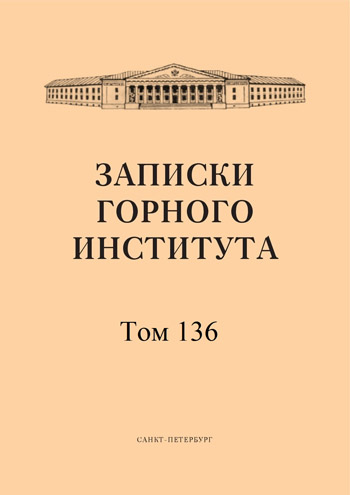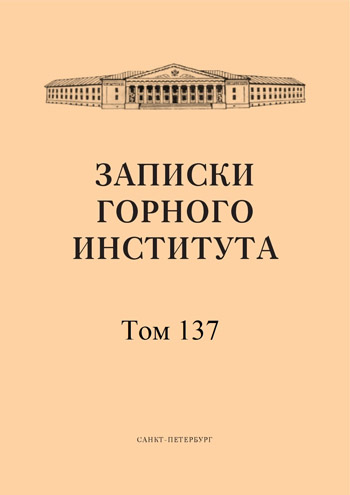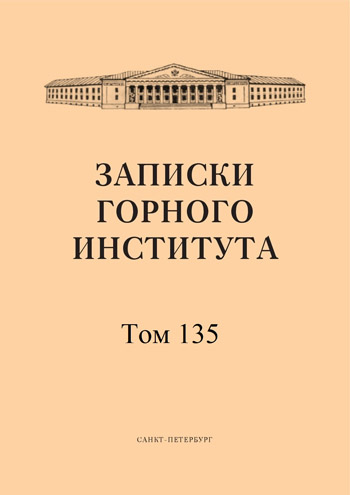-
Date submitted1992-07-15
-
Date accepted1992-09-16
-
Date published1993-06-03
Experimental study of the influence of penetrator shape on fusion drilling efficiency
- Authors:
- Vladimir S. Litvinenko
- G. N. Soloviev
Under the efficiency of the process of drilling rocks by fusion should be understood not only the rate of deepening into the rock, but also such factors as the diameter of the well, its ratio with the diameter of the penetrator, the amount of melt formed per unit time, the thickness of vitrified melt on the walls of the well, its strength, the specific energyb consumption per unit of penetration and many other.
-
Date submitted1992-07-26
-
Date accepted1992-09-11
-
Date published1993-06-03
Current state and prospects of geological exploration drilling development
- Authors:
- I. S. Afanasyev
In 1988 more than 25.5 million meters of wells were drilled for solid minerals in our country. Obviously, this was the maximum for all the years of existence of the geological industry, and it is unlikely that such a volume of drilling will be achieved in the future. However, during the period 1968-1990 the volume of geological exploration drilling decreased by almost 3 million meters. What are the main reasons for the decline in drilling?
-
Date submitted1992-07-29
-
Date accepted1992-09-30
-
Date published1993-06-03
Calculation of fusion core drilling speed with liquid coolant
- Authors:
- B. B. Kudryashov
- N. G. Menshikov
The energy intensity of fusion ice drilling is many times higher than that of mechanical destruction. A significant advantage of the fusion ice drilling method is the simplicity of design and reliability of thermoelectric drilling shells on a load-carrying cable, so they have been widely used in the domestic practice of studying glaciers and ice sheets with the help of deep boreholes and allowed to achieve record results.
-
Date submitted1992-07-09
-
Date accepted1992-09-28
-
Date published1993-06-03
Hydraulic resistances to movement of the drilling rig on the cable in the borehole during up-and-down operations
- Authors:
- N. I. Vasiliev
- B. B. Kudryashov
Deep drilling of ice deposits in the Arctic and Antarctic is carried out mainly by electromechanical and electrothermal drilling shells on a load-carrying cable.
-
Date submitted1992-07-14
-
Date accepted1992-09-20
-
Date published1993-06-03
Comparative characterization of the efficiency of penetrators of different shapes for thermal drilling
- Authors:
- O. F. Putikov
- Vladimir S. Litvinenko
To evaluate the efficiency of the shape of the working surface of the heating device (penetrator) of thermal drilling, it was previously proposed to use their efficiency.
-
Date submitted1992-07-03
-
Date accepted1992-09-19
-
Date published1993-06-03
Analysis of the contact melting process during well drilling for media with nonlinear thermophysical and rheological characteristics
- Authors:
- V. K. Chistyakov
- V. A. Chugunov
Fusion drilling technology is based on unconventional, purely physical methods of destruction and consolidation of rocks associated with changes in their aggregate state as a result of intensive heating in the bottom-hole zone.
-
Date submitted1992-07-29
-
Date accepted1992-09-18
-
Date published1993-06-03
Fusion drilling is one of the methods for solving geomechanics problems
- Authors:
- A. M. Shkurko
More than 30 years ago at international conferences it was decided to organize the International Geophysical Year (IGY). Within the framework of this decision, the scientific research of Antarctica, agreed between the IYYG participating countries, began.
-
Date submitted1992-07-17
-
Date accepted1992-09-03
-
Date published1993-06-03
Temperature regime of the borehole being drilled and the surrounding frozen rock massif
- Authors:
- A. V. Kozlov
- A. A. Yakovlev
Predicting the temperature regime of the borehole being drilled is one of the main tasks of designing drilling technology in the zones of frozen rock distribution.
-
Date submitted1992-07-25
-
Date accepted1992-09-17
-
Date published1993-06-03
Peculiarities of geothermal well development technology
- Authors:
- Yu. M. Pariysky
The complex of works on causing the inflow of liquid from the productive zone (well development) is the final operation in the technological cycle of well construction for liquid and gaseous minerals, the quality of execution of which largely determines the possibility of obtaining commercial inflow of liquid and the efficiency of drilling operations.
-
Date submitted1992-07-16
-
Date accepted1992-09-19
-
Date published1993-06-03
Contact problem of dynamic interaction of diamond crown with rock massif
In the design of diamond rock-cutting tools, of considerable interest is the evaluation of their stress-strain state during drilling, or dynamic interaction with the rock mass.
-
Date submitted1992-07-04
-
Date accepted1992-09-12
-
Date published1993-06-03
Temperature regime of stepped diamond bits during drilling with foam
- Authors:
- A. A. Yakovlev
- A. V. Kozlov
The accumulated experience has shown the necessity of taking into account the temperature factor when designing rational designs of diamond rock-destroying tools intended for sinking wells with bottom-hole cleaning by foam, and the optimal technology of their development.
-
Date submitted1992-07-01
-
Date accepted1992-09-04
-
Date published1993-06-03
Evaluation of diamond drilling efficiency by mist blowing
- Authors:
- A. T. Alexandrov
- M. Azam
At present, gas-liquid cleaning agents are widely used in drilling exploration wells.
-
Date submitted1992-07-23
-
Date accepted1992-09-11
-
Date published1993-06-03
Assessment of the complexity of diamond drilling conditions
- Authors:
- Yu. M. Pariysky
- M. Bundy
The complexity of the conditions of diamond drilling of exploration wells is one of the significant factors affecting its efficiency.
-
Date submitted1992-07-21
-
Date accepted1992-09-14
-
Date published1993-06-03
Peculiarities of foam formation and flow in a well
- Authors:
- V. Ya. Klimov
- Xi Huiwen
Over the last decade, foam as a cleaning agent has become widespread in the drilling of wells for solid minerals.
-
Date submitted1992-07-07
-
Date accepted1992-09-07
-
Date published1993-06-03
Drilling wells under water influx conditions using gas-liquid mixtures
- Authors:
- A. M. Yakovlev
The effectiveness of drilling wells using gas-liquid mixtures (GLMs) in certain orografic-climatic and hydrogeologic conditions is known.
-
Date submitted1992-07-01
-
Date accepted1992-09-23
-
Date published1993-06-03
Determination of griffin flow rate in hydrogeological mineral water wells
- Authors:
- D. N. Bashkatov
- V. A. Bloshitsyn
The occurrence of oil springs and inter-column water-gas blowouts causes severe consequences.
-
Date submitted1992-07-12
-
Date accepted1992-09-04
-
Date published1993-06-03
Tubeless consolidation of unstable intervals of exploration wells
- Authors:
- N. I. Nikolaev
One of the most common types of geologic complications arising during drilling for solid minerals is a breach of borehole integrity due to changes in the natural stress state of the surrounding rock massif.
-
Date submitted1992-07-29
-
Date accepted1992-09-09
-
Date published1993-06-03
Technological peculiarities of well plugging using SSC complex
- Authors:
- N. I. Nikolaev
- L. K. Gorshkov
Widespread introduction of SSC complexes into the practice of drilling operations allowed to significantly reduce non-productive time spent on downhole operations.
-
Date submitted1992-07-16
-
Date accepted1992-09-02
-
Date published1993-06-03
Study of plugging compositions for artificial filters
The arrangement of the filter part of water wells significantly affects the efficiency and duration of the bottom-hole zone.
-
Date submitted1992-07-22
-
Date accepted1992-09-11
-
Date published1993-06-03
Methodology of drilling mud development for penetration of unstable rocks containing clay minerals
- Authors:
- I. V. Udodova
- D. I. Beresneva
- A. N. Kholodok
When developing drilling fluid formulations, first of all, the geological situation should be assessed, the mineral composition should be determined and the properties of the rocks to be drilled should be comprehensively studied.
-
Date submitted1992-07-04
-
Date accepted1992-09-20
-
Date published1993-06-03
Toward the design of optimal systems for percussion drilling
- Authors:
- I. G. Shelkovnikov
Impact energy is widely used in a variety of hard rock drilling methods.
-
Date submitted1992-07-14
-
Date accepted1992-09-07
-
Date published1993-06-03
Use of the Maxwell-Cremona diagram in the calculation of derricks
- Authors:
- I. G. Shelkovnikov
- N. D. Mikhailova
In the field of structural mechanics, the forces in the bars of unmodified trusses resulting from static loading are often determined using the graphostatic method of constructing a combined Maxwell-Cremona diagram.
-
Date submitted1992-07-27
-
Date accepted1992-09-04
-
Date published1993-06-03
Selection of criterion and calculation method for drill string bottom layouts for core drilling
Calculation and design of bottom of drill string (BHA) assemblies involves the determination of such geometric parameters (diameter of the centralizers and their location relative to the drill bit), at which the maximum functional effect.
-
Date submitted1992-07-03
-
Date accepted1992-09-30
-
Date published1993-06-03
On some problems of drilling of inclined-horizontal wells
- Authors:
- V. V. Artemyev
- V. A. Ushkalo
Over the past 10-15 years, global oil and gas drilling practice has seen an increase in the construction of directional wells, including those with significant bottom-hole waste in the horizontal plane
-
Date submitted1992-07-21
-
Date accepted1992-09-17
-
Date published1993-06-03
Ways of creation of means of automatic drilling of extended precisely directed wells
- Authors:
- N. P. Boytsov
- V. K. Bubok
Nowadays, worldwide, drilling of long directional wells is an urgent problem in geological exploration, oil, coal, gas industries, as well as in the construction of long communications.
-
Date submitted1992-07-08
-
Date accepted1992-09-26
-
Date published1993-06-03
Experience in creating long horizontally directed wells
- Authors:
- Yu. B. Sinai
- V. Kh. Samigulin
The ability to reliably drill long horizontal directional wells often predetermines the selection of new efficient technologies in various industries.


